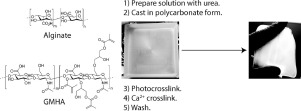当前位置:
X-MOL 学术
›
Acta Biomater.
›
论文详情
Our official English website, www.x-mol.net, welcomes your
feedback! (Note: you will need to create a separate account there.)
Polysaccharide-based films for the prevention of unwanted postoperative adhesions at biological interfaces.
Acta Biomaterialia ( IF 9.4 ) Pub Date : 2020-02-22 , DOI: 10.1016/j.actbio.2020.02.027 Sarah M Mayes 1 , Jessica Davis 1 , Jessica Scott 1 , Vanessa Aguilar 1 , Scott A Zawko 2 , Steve Swinnea 2 , Daniel L Peterson 1 , John G Hardy 3 , Christine E Schmidt 3
Acta Biomaterialia ( IF 9.4 ) Pub Date : 2020-02-22 , DOI: 10.1016/j.actbio.2020.02.027 Sarah M Mayes 1 , Jessica Davis 1 , Jessica Scott 1 , Vanessa Aguilar 1 , Scott A Zawko 2 , Steve Swinnea 2 , Daniel L Peterson 1 , John G Hardy 3 , Christine E Schmidt 3
Affiliation

|
Postoperative adhesions protect, repair, and supply nutrients to injured tissues; however, such adhesions often remain permanent and complicate otherwise successful surgeries by tethering tissues together that are normally separated. An ideal adhesion barrier should not only effectively prevent unwanted adhesions but should be easy to use, however, those that are currently available have inconsistent efficacy and are difficult to handle or to apply. A robust hydrogel film composed of alginate and a photo-crosslinkable hyaluronic acid (HA) derivative (glycidyl methacrylate functionalized hyaluronic acid (GMHA)) represents a solution to this problem. A sacrificial porogen (urea) was used in the film manufacture process to impart macropores that yield films that are more malleable and tougher than equivalent films produced without the sacrificial porogen. The robust mechanical behavior of these templated alginate/GMHA films directly facilitated handling characteristics of the barrier film. In a rat peritoneal abrasion model for adhesion formation, the polysaccharide films successfully prevented adhesions with statistical equivalence to the leading anti-adhesion technology on the market, Seprafilm®. STATEMENT OF SIGNIFICANCE: Postoperative adhesions often remain permanent and complicate otherwise successful surgeries by tethering tissues together that are normally separated and pose potentially significant challenges to patients. Therefore, the generation of adhesion barriers that are easy to deploy during surgery and effectively prevent unwanted adhesions is a big challenge. In this study robust hydrogel films composed of alginate and a photo-crosslinkable hyaluronic acid (HA) derivative (glycidyl methacrylate functionalized HA, GMHA) were fabricated and investigated for their potential to act as a solution to this problem using a rat peritoneal abrasion model for adhesion formation. We observed the polysaccharide films successfully prevented adhesions with statistical equivalence to the leading anti-adhesion technology on the market, Seprafilm®, suggesting that such films represent a promising strategy for the prevention of postoperative adhesions.
中文翻译:

基于多糖的薄膜,用于防止生物界面上不必要的术后粘连。
术后粘连保护、修复受损组织并为其提供营养;然而,这种粘连通常是永久性的,并且将通常分离的组织束缚在一起,从而使原本成功的手术变得复杂。理想的防粘连屏障不仅应有效防止不必要的粘连,而且应易于使用,然而,目前可用的那些防粘连效果不一致并且难以处理或应用。由海藻酸盐和可光交联的透明质酸(HA)衍生物(甲基丙烯酸缩水甘油酯官能化透明质酸(GMHA))组成的坚固水凝胶膜代表了这一问题的解决方案。在薄膜制造过程中使用牺牲性致孔剂(尿素)来赋予大孔,所产生的薄膜比没有牺牲性致孔剂生产的同等薄膜更具延展性和韧性。这些模板化藻酸盐/GMHA 薄膜的稳健机械性能直接促进了阻隔薄膜的处理特性。在用于形成粘连的大鼠腹膜磨损模型中,多糖膜成功地防止了粘连,其统计效果与市场上领先的防粘连技术 Seprafilm® 相当。意义声明:术后粘连通常会保持永久性,并且将通常分离的组织束缚在一起,使原本成功的手术变得复杂化,并对患者构成潜在的重大挑战。因此,生成易于在手术过程中部署并有效防止不必要的粘连的粘连屏障是一个巨大的挑战。 在本研究中,制备了由海藻酸盐和可光交联的透明质酸 (HA) 衍生物(甲基丙烯酸缩水甘油酯功能化 HA,GMHA)组成的坚固水凝胶薄膜,并使用大鼠腹膜磨损模型研究了其作为解决该问题的潜力。粘附形成。我们观察到多糖薄膜成功地防止了粘连,其统计数据与市场上领先的防粘连技术 Seprafilm® 相当,表明此类薄膜代表了预防术后粘连的一种有前途的策略。
更新日期:2020-02-23
中文翻译:

基于多糖的薄膜,用于防止生物界面上不必要的术后粘连。
术后粘连保护、修复受损组织并为其提供营养;然而,这种粘连通常是永久性的,并且将通常分离的组织束缚在一起,从而使原本成功的手术变得复杂。理想的防粘连屏障不仅应有效防止不必要的粘连,而且应易于使用,然而,目前可用的那些防粘连效果不一致并且难以处理或应用。由海藻酸盐和可光交联的透明质酸(HA)衍生物(甲基丙烯酸缩水甘油酯官能化透明质酸(GMHA))组成的坚固水凝胶膜代表了这一问题的解决方案。在薄膜制造过程中使用牺牲性致孔剂(尿素)来赋予大孔,所产生的薄膜比没有牺牲性致孔剂生产的同等薄膜更具延展性和韧性。这些模板化藻酸盐/GMHA 薄膜的稳健机械性能直接促进了阻隔薄膜的处理特性。在用于形成粘连的大鼠腹膜磨损模型中,多糖膜成功地防止了粘连,其统计效果与市场上领先的防粘连技术 Seprafilm® 相当。意义声明:术后粘连通常会保持永久性,并且将通常分离的组织束缚在一起,使原本成功的手术变得复杂化,并对患者构成潜在的重大挑战。因此,生成易于在手术过程中部署并有效防止不必要的粘连的粘连屏障是一个巨大的挑战。 在本研究中,制备了由海藻酸盐和可光交联的透明质酸 (HA) 衍生物(甲基丙烯酸缩水甘油酯功能化 HA,GMHA)组成的坚固水凝胶薄膜,并使用大鼠腹膜磨损模型研究了其作为解决该问题的潜力。粘附形成。我们观察到多糖薄膜成功地防止了粘连,其统计数据与市场上领先的防粘连技术 Seprafilm® 相当,表明此类薄膜代表了预防术后粘连的一种有前途的策略。











































 京公网安备 11010802027423号
京公网安备 11010802027423号